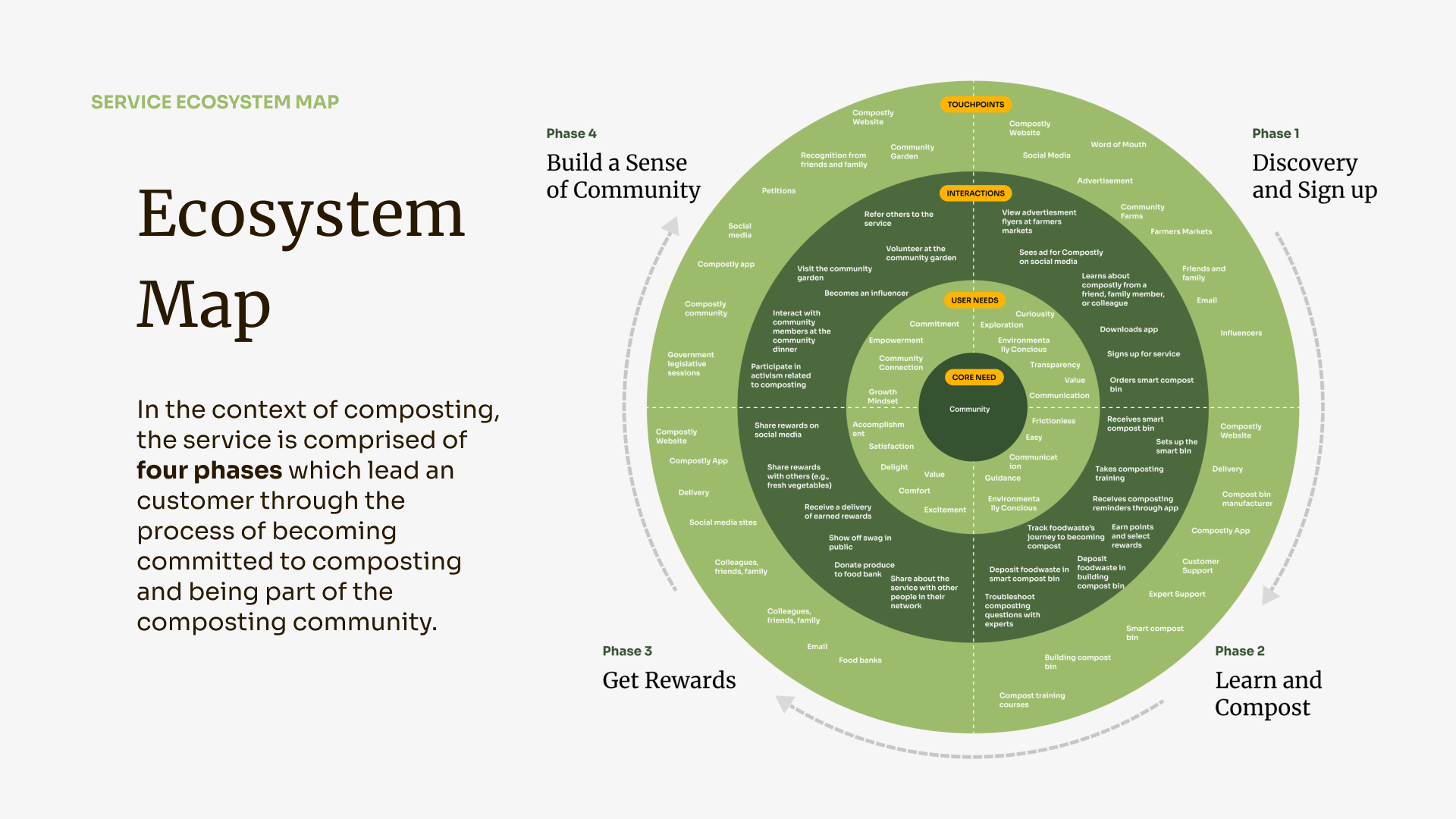Compost service design project
As part of my Human Centered Design and Engineering master’s degree, I worked with a team to develop a composting service called Compostly. We implemented a variety of service design techniques, including ecosystem mapping, co-design, and roleplay prototyping.




































Timeline
September 2022 to December 2022
Problem
Through our initial research, we learned that 30 to 40 percent of food is wasted in the U.S. This leads to more waste in the landfills and methane in the air. Food waste generates around 10 percent of global emissions (Rainforest Alliance).
Only 27 percent of people in the U.S. compost. Through our initial user research, we learned that users don’t compost because of their perceived lack of knowledge and the stench and mess associated with composting at home.
Team structure
1 Content designer (me)
1 Product designer
1 User researcher
Our objective
Create a rewarding, community-centric and easy composting experience for people who want to minimize food waste.
The process
Research
We conducted a survey, user interviews, and secondary research to gain a foundational understanding of peoples’ feelings toward composting. Initially, we wanted to focus on food packaging. However, we decided to narrow our research scope to composting because packaging waste is a very broad space.
Our research revealed that people feared that composting generates bad odors and attracts pests. Additionally, they didn’t have the space or backyard needed to start composting. They didn’t feel motivated to compost because it was just easier to throw the food waste in the garbage.
Ecosystem mapping
Next, we created a service ecosystem map to identify the touch points, interactions, and user needs. This helped us better understand who would be involved in our service and how we could meet their needs. We identified our main user group as inexperienced composters.
Co-design
We conducted a co-design activity to understand how users’ envisioned an ideal and easy-to-use compost service where they felt encouraged and rewarded to create compost. Through these activities, we learned:
Composting at home can be messy: Participants don’t like the stench that compost produces, along with potential bugs and pests it attracts. Also, composting can be messy and hard to clean.
It’s challenging to know what’s compostable: Both the novice and expert composters expressed that it's challenging to know what's compostable or not. Plus, it’s difficult to find helpful resources.
Users want recognition: Some participants care more about showing how woke they are to other people and a major part of their motivation to compost comes from being able to show everyone that they are composting and helping the environment.
Users want to know the impact they’re making: People want to know what impact their compost is making, whether that's insight into how it's used at the community garden or how much compost they've produced.
Journey mapping and service blue printing
Using insights from our user research and co-design, we developed a user journey and service blueprint to highlight the needs and interactions a user has with the service.
Role play prototyping
Next, we participated in a prototyping technique where we acted out our service. This helped us develop more empathy for our user and learn where potential pain points may occur. For example, in our scenario I played a customer service representative and one of my teammates played a user. They called in to ask a question about composting. Through this scenario, we gained insight into the anxiety someone may feel when trying to compost through our service. It’s important the customer representative is prepared to answer a range of questions in a respectful and friendly tone.
Presentation
We applied insights from our research process to create an end-to-end service. I used our values (knowledge sharing, rewarding, and community-centric) to create copy for the presentation. I also developed voice and tone guidance for our service based on these values.
We presented our service to our classmates and industry professionals.
Challenges
Short timeline
We only had ten weeks to complete the E2E service design process. To achieve our goal, we scaled down our project to focus solely on composting. I helped our team stay on track by setting a timeline and getting alignment from my team members.


